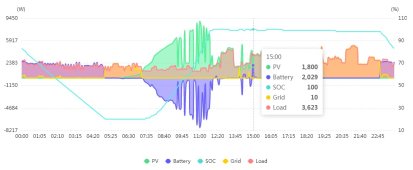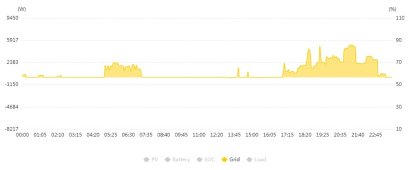Hedges
I See Electromagnetic Fields!
- Joined
- Mar 28, 2020
- Messages
- 21,839
I think there is an Ethernet/Speedwire card for Sunny Island, but last I heard it didn't support the on/off grid communication needed by Sunny Boy.
I figured that might get implemented in firmware of SI 8.0, and it is possible that is supported by SI 6048US. You could email SMA support to ask.
If you put RS-485 card in master Sunny Island and one in each Sunny Boy, and set Sunny Boy to grid-backup:
Backup mode = On all
or
Op.BckOpMod = OnAllPhs
Then it will enable backup automatically when SI disconnects from grid.
Are you switching AC wires of Sunny Boy from grid to island side of Sunny Island? I thought about that, and would have switched RS-485 as well. Don't want Sunny Island setting "backup" mode while Sunny Boy is connected direct to grid. But, I have never seen the Sunny Island message with an oscilloscope. I don't know if it is a one-time message, or a repeating "keep alive" message. So I don't now if switching RS-485 will let the message through vs. blocking "backup" mode, or if doing so might miss the message and leave Sunny Boy in wrong state.
When I discovered 10000TLUS did not respond to frequency shift by reducing power output (simply remained connected at full power up to 64.5 Hz), SMA America acknowledged the bug and gave me the work-around of using off-grid ("Island") mode for that model Sunny Boy when behind Sunny Island (NOT directly on grid) whether running with grid connected or during power failures.
That worked, but I have a concern. It disagrees with written instructions from SMA Germany:
"For PV inverters without backup mode, the country data set must be set to the locally typical value for grid-tie PV
systems as per UL1741. The PV inverter is then configured for operation on the utility grid. In the event of a utility
grid failure, the Sunny Island is unable to derate the PV inverters by means of Frequency-Shift Power Control (FSPC).
If there is an excessive supply of energy, the PV inverters will switch off."
Although it works just fine, I think there was a reason the developers implemented a backup mode rather than just on-grid for direct grid connection and off-grid when behind Sunny Island, regardless of whether a grid is connected or not. Going through FMEA, one would realize the relay could get welded and leave grid and island side connected. Sunny Island (if so designed) could recognize relay never opened, and not invert to produce AC from battery. It could decide not to tell Sunny Boy to enter backup mode. With Sunny Boy still in UL-1741 mode, anti-islanding would guarantee it shut off.
If Sunny Boy was set to off-grid, relying on Sunny Island to isolate it during grid-down, that wouldn't happen in case of welded relay. Grid would remain connected to Sunny Boy, which would not perform anti-islanding and could continue to deliver power. So I didn't trust the workaround I was given, and have since switched to SB 5000US which works as intended with RS-485.
I figured that might get implemented in firmware of SI 8.0, and it is possible that is supported by SI 6048US. You could email SMA support to ask.
If you put RS-485 card in master Sunny Island and one in each Sunny Boy, and set Sunny Boy to grid-backup:
Backup mode = On all
or
Op.BckOpMod = OnAllPhs
Then it will enable backup automatically when SI disconnects from grid.
Are you switching AC wires of Sunny Boy from grid to island side of Sunny Island? I thought about that, and would have switched RS-485 as well. Don't want Sunny Island setting "backup" mode while Sunny Boy is connected direct to grid. But, I have never seen the Sunny Island message with an oscilloscope. I don't know if it is a one-time message, or a repeating "keep alive" message. So I don't now if switching RS-485 will let the message through vs. blocking "backup" mode, or if doing so might miss the message and leave Sunny Boy in wrong state.
When I discovered 10000TLUS did not respond to frequency shift by reducing power output (simply remained connected at full power up to 64.5 Hz), SMA America acknowledged the bug and gave me the work-around of using off-grid ("Island") mode for that model Sunny Boy when behind Sunny Island (NOT directly on grid) whether running with grid connected or during power failures.
That worked, but I have a concern. It disagrees with written instructions from SMA Germany:
"For PV inverters without backup mode, the country data set must be set to the locally typical value for grid-tie PV
systems as per UL1741. The PV inverter is then configured for operation on the utility grid. In the event of a utility
grid failure, the Sunny Island is unable to derate the PV inverters by means of Frequency-Shift Power Control (FSPC).
If there is an excessive supply of energy, the PV inverters will switch off."
Although it works just fine, I think there was a reason the developers implemented a backup mode rather than just on-grid for direct grid connection and off-grid when behind Sunny Island, regardless of whether a grid is connected or not. Going through FMEA, one would realize the relay could get welded and leave grid and island side connected. Sunny Island (if so designed) could recognize relay never opened, and not invert to produce AC from battery. It could decide not to tell Sunny Boy to enter backup mode. With Sunny Boy still in UL-1741 mode, anti-islanding would guarantee it shut off.
If Sunny Boy was set to off-grid, relying on Sunny Island to isolate it during grid-down, that wouldn't happen in case of welded relay. Grid would remain connected to Sunny Boy, which would not perform anti-islanding and could continue to deliver power. So I didn't trust the workaround I was given, and have since switched to SB 5000US which works as intended with RS-485.





